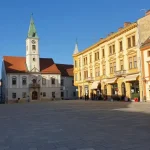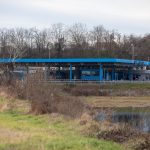A look at everything that has been done over the last four years concerning the accessibility of buildings and areas for people with disabilities.
To be honest, I had never really thought about accessibility in Split being an issue until a friend of mine in a wheelchair visited me here.
Once I received the call, my immediate thoughts jumped to, “Diocletian’s Palace is 1700 years old. Our streets are cobblestone. All of the apartments have stairs, and a lot of them.” And being that he was visiting in the summer, “what beaches are accessible?”
Knowing that he wouldn’t be able to stay with me because I live in an apartment 20-minutes outside of the city center, and up five flights of stairs, I quickly did a hotel check to see which hotels in the center were wheelchair accessible.
Hotel Marmont, Cornaro, and Palace Suites all had lifts, and being that they were all located in the center, either of these would be a good option. He ended up booking Marmont.
My friend has traveled the world with his disability and was not as nervous as I was in making sure he would be able to navigate through Split, so I remained hopeful that we would make this work.
Once he arrived in Split, he was able to order an Uber XL from the airport, a typical move he makes when he travels anywhere that has Uber – the first hurdle complete. Thank you, Uber.
Once he arrived at Hotel Marmont, the lift painlessly escorted him to the fifth floor, and the room was large enough to accommodate his needs. It even had a handicap accessible toilet – another bonus.
Lucky for him, he was on a motorized scooter, making traveling around the cobblestones of the center a bit easier than powering over them with arm strength. The restaurants in the center he found to be more than accommodating (thank you Mazzgoon) but I continued to question which beach we would go to during his visit.
A beach club, I thought, would be the best option. And since taking an Uber XL was not a problem, we would go to ZEN Beach Club on Znjan.
A wooden walkway to our table there proved to be much simpler than anticipated, and camping there for the day was mostly effortless.
While my friend found maneuvering around Split for two days to be manageable, what really has been done in Split to make it more accessible?
Facebook group For an Accessible Split highlights the disadvantages people with disabilities encounter in the city of Split every day.
Just yesterday, a member of the group published a list of everything that has been done over the past four years concerning the accessibility of public buildings and areas in Split. And because an accessible Split would certainly mean more access to individual buildings, entrances and institutions, how much has been done?
With that said, here are the six measures Split has taken to help those with disabilities.
1. In the reconstruction of the bridge at Bačvice, crossings have been constructed for OSI, and two ramps connect with Bačvice.
2. The Tourist Palace has a toilet for the disabled and a lift.
3. The Professional Rehabilitation Center at Sinjska 2 has been created to train persons with disabilities for the labor market.
4. The Center for Autism at Rendićeva has been set up as a special institution for those up to 21 years of age. There have also been activities to establish an institution for elderly sufferers of autism.
5. House for Parents at Gundulićeva offers free accommodation for parents of children in treatment or rehabilitation in Split. The building is 350 m2 and was supported by the Association for the Unemployed SDŽ.
6. The Sports Hall at Gripe made building adjustments for easier access for people with disabilities. And as nice as “building adjustments” sound, they only created a concrete ramp at the main entrance.
For many years now, many citizens of Split-Dalmatia County have complained about the lack of infrastructure for people with disabilities, reports Dalmacija Plus on July 31, 2017.
While the city of Split is the second largest city in Croatia, it is, unfortunately, one of the first cities to list its citizens as second-class if they have disabilities. This title, unfortunately, has been deserved many times, and many politicians are quick to ignore the demands of people with disabilities – roughly 22,000 citizens of Split are forced to live as second-class citizens in the city.
Dalmacija Plus writes that access to Diocletian’s Palace and the city’s core is almost entirely inaccessible for wheelchair users, forcing many to navigate the city center by circling from one location to another. Many shops, restaurants and cafes in the narrow city center are not accessible because there is typically at least one staircase that must be crossed.
Although the City of Split signed the Charter on Accessibility of Public Premises for Persons with Disabilities in 2012, to date, very little has been done, and almost nothing has been touched on regarding accessibility issues. And though the government has changed several times over the last five years, at the city, county and national level, the problems for people with disabilities remain.
Dalmacija Plus further points out that the Department for Expertise, Professional Rehabilitation and Employment of Disabled Persons, which has operated in Split since 2015, is located in an old building that is not accessible – no lifts or ramps in sight.
Transportation, one of the fundamental conditions for achieving equal opportunities and full enjoyment of human rights, proves to be another issue in Split.
Split’s public transport company Promet does not have many buses fully adapted for disabled people. Typically, if you’re in a wheelchair and want to ride the city bus, you’ll have to wait at the bus station for a bus that can accommodate you.
While this is standard practice in most large cities, Split buses, unfortunately, still have no display or audio message that provide information about the current and next station to the deaf and blind.
While some measures have been taken into account, including the fact that 5% of all parking lots in Split must be dedicated to the disabled, we can only hope that Split will take a great leap forward in their efforts to make the city more accessible for people with disabilities.
The mission statement of Facebook group For an Accessible Split reads:
“We are here to warn you of any breach of the Ordinance on the accessibility of buildings for people with disabilities and reduced mobility. We are here to build an accessible Split together for the future, a city of universal design tailored to everyone.”
While my friend had the luxury of using Uber XL to get around, this is not a reality for most. For day to day life in the city, what actions will Split take to ensure we can accommodate everyone?







